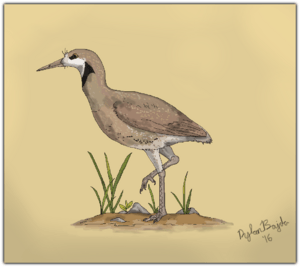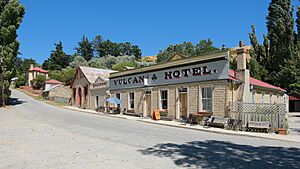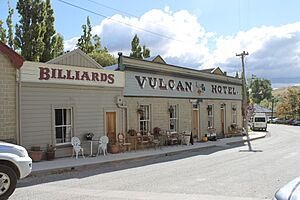Saint Bathans facts for kids
St Bathans is a small, historic town in Central Otago, New Zealand. It used to be a busy place for gold and coal mining. In the past, it was known as Dunstan Creek. St Bathans was a key spot during the exciting Otago gold rush.
Today, mining has stopped, and St Bathans has become a popular place for holidays. Many of its old buildings have been kept safe, making it feel like a step back in time. People also visit to try their hand at finding gold.
St Bathans is famous for its special place called Blue Lake. This lake was made by people during the gold mining days. Miners used a method called sluicing to find gold, which dug a huge hole. This hole was once a 120-meter high hill called Kildare Hill. After mining stopped in 1934, the hole filled with water. The water turned a beautiful blue color because of minerals from the rocks around it. Now, Blue Lake is a great spot for camping and swimming.
The town got its name from a village in Scottish Borders called Abbey St Bathans. An early surveyor named John Turnbull Thomson chose the name because his grandfather was born there. St Bathans is about 40 kilometers northwest of Ranfurly and 60 kilometers northeast of Alexandra. It sits near the Dunstan Creek, surrounded by the St Bathans Range and Dunstan mountains.
Contents
The Famous Vulcan Hotel
The Vulcan Hotel is a very old and well-kept hotel on the main street of St Bathans. It's one of the town's biggest attractions for visitors. The hotel was built in 1882 using mud bricks. It was first called the Ballarat Hotel.
This building is so important that Heritage New Zealand has listed it as a Category I historic place. The Vulcan Hotel is also famous for another reason: many people believe it is one of New Zealand's most well-known haunted buildings.
Ancient Animals and Geology
St Bathans is also important for science! The town gives its name to the Saint Bathans Fauna. This is a collection of very old fossils found in the area. These fossils are from about 19 to 16 million years ago.
The layers of rock where these fossils are found were once the bottom of a large, shallow freshwater lake. This lake had wide floodplains around it. Scientists have found these fossil layers along the Manuherikia River near the town.
The Saint Bathans Mammal
In 2006, scientists made an amazing discovery near St Bathans. They found fossils of a non-flying mammal. Before this, people thought that bats were the only land mammals native to New Zealand. This new discovery was nicknamed the "SB mammal" (for Saint Bathans).
Scientists studied the fossils and found that this creature was different from other types of mammals. It was not like egg-laying mammals (monotremes), eutherians (mammals with placentas), or metatherians (marsupials). This finding changed what we know about New Zealand's ancient animal life.
Other Ancient Animals

The St Bathans area has also given us fossils of many other incredible ancient animals. These include large, flightless moa birds, crocodile-like creatures called mekosuchine crocodiles, and turtles.
Scientists have also found fossils of skinks, tuataras, and geckoes. There are also fossils of at least eight different types of waterfowl, a petrel (a type of seabird), and birds like Accipitriformes (eagles and hawks), rails, and even a possible seagull.
Other finds include herons, a type of flamingo, pigeons, parrots, a swift, an owlet-nightjar, and many small passerine birds. They even found fossils of the mysterious Aptornis and an early type of kiwi bird, called Proapteryx.
Climate in St Bathans
The weather in St Bathans changes throughout the year. It can get quite warm in summer and cold in winter.
| Climate data for Saint Bathans, elevation 585 m (1,919 ft), (1991–2020) | |||||||||||||
|---|---|---|---|---|---|---|---|---|---|---|---|---|---|
| Month | Jan | Feb | Mar | Apr | May | Jun | Jul | Aug | Sep | Oct | Nov | Dec | Year |
| Mean daily maximum °C (°F) | 22.6 (72.7) |
22.7 (72.9) |
20.2 (68.4) |
16.1 (61.0) |
12.5 (54.5) |
8.8 (47.8) |
8.3 (46.9) |
10.3 (50.5) |
13.6 (56.5) |
16.0 (60.8) |
17.9 (64.2) |
20.8 (69.4) |
15.8 (60.5) |
| Daily mean °C (°F) | 16.1 (61.0) |
15.8 (60.4) |
13.7 (56.7) |
10.3 (50.5) |
7.4 (45.3) |
4.1 (39.4) |
3.4 (38.1) |
5.6 (42.1) |
8.2 (46.8) |
10.1 (50.2) |
11.5 (52.7) |
14.2 (57.6) |
10.0 (50.1) |
| Mean daily minimum °C (°F) | 9.6 (49.3) |
8.9 (48.0) |
7.2 (45.0) |
4.5 (40.1) |
2.3 (36.1) |
−0.6 (30.9) |
−1.5 (29.3) |
0.6 (33.1) |
2.7 (36.9) |
4.3 (39.7) |
5.1 (41.2) |
7.6 (45.7) |
4.2 (39.6) |
| Average rainfall mm (inches) | 61.0 (2.40) |
47.0 (1.85) |
68.0 (2.68) |
58.0 (2.28) |
47.0 (1.85) |
49.0 (1.93) |
37.0 (1.46) |
35.0 (1.38) |
52.0 (2.05) |
58.0 (2.28) |
67.0 (2.64) |
67.0 (2.64) |
646 (25.44) |
| Source: CliFlo (rain 1951–1980) | |||||||||||||




